
|
It approached to Sun down to 0.09 a.u. on Jan. 13. It brightened up to -2 or -3 mag and it was detected even in the daylight. The nucleus was disintegrated on Jan. 19. However, its long tail is still visible. Now it is 3.2 mag (Jan. 23, Willian Souza). Fading rapidly. In the Northern Hemisphere, it will never be observable after this. It stays extremely low in the Southern Hemisphere. But it will become high in spring.
Date(TT) R.A. (2000) Decl. Delta r Elong. m1 Best Time(A, h)
Jan. 25 21 50.37 -31 11.5 1.230 0.486 21 4.3 18:48 ( 58, -9)
Feb. 1 22 24.16 -34 53.4 1.421 0.690 26 6.2 18:55 ( 55,-11)
|

|
It brightened up to -3 mag due to the forward scattering on Oct. 9 in the SOHO coronagraph images (Q.-c. Zhang, Charles S. Morris). It became a great comet of 0 mag on the ground. Now it is 10.5 mag (Jan. 14, Ken-ichi Kadota). Fading slowly. In the Northern Hemisphere, it will be getting higher gradually. In the Southern Hemisphere, it is not observable now, but it will appear in March.
Date(TT) R.A. (2000) Decl. Delta r Elong. m1 Best Time(A, h)
Jan. 25 20 1.30 8 41.1 3.154 2.337 28 11.3 5:35 (262, 3)
Feb. 1 20 6.15 9 30.8 3.245 2.438 29 11.5 5:32 (264, 8)
|

|
It has not been observed yet in this apparition. It will turn to fade out rapidly after the peak. It will be fainter than 18 mag in March. Now it is not observable. It will appear in March in the Northern Hemisphere. In the Southern Hemisphere, it will never be observable after this.
Date(TT) R.A. (2000) Decl. Delta r Elong. m1 Best Time(A, h)
Jan. 25 19 46.86 -19 18.0 1.469 0.527 9 11.9 5:35 (287,-10)
Feb. 1 20 41.53 -15 39.9 1.477 0.500 4 11.5 5:32 (280,-14)
|

|
Brightening slowly. Now it is not observable. It will brighten up to 10 mag in spring. But the condition of this apparition is bad. It is not observable when the comet is bright.
Date(TT) R.A. (2000) Decl. Delta r Elong. m1 Best Time(A, h)
Jan. 25 20 20.00 -1 57.8 2.212 1.305 17 12.6 5:35 (268, -7)
Feb. 1 20 45.61 -1 23.1 2.165 1.248 16 12.2 5:32 (267, -7)
|

|
It returned for the first time in 68 years. It brightened up to 6.2 mag in early summer (July 1, Virgilio Gonano). Fading slowly. It locates somewhat low in the Northern Hemisphere. In the Southern Hemisphere, it will be getting higher gradually.
Date(TT) R.A. (2000) Decl. Delta r Elong. m1 Best Time(A, h)
Jan. 25 17 58.04 -17 41.1 3.753 3.010 35 13.1 5:35 (301, 11)
Feb. 1 18 5.97 -18 11.4 3.758 3.081 40 13.3 5:32 (304, 14)
|
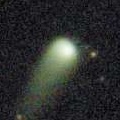
|
Now it is 12.8 mag (Jan. 17, Osamu Miyazaki). Fading slowly. In the Northern Hemisphere, it will be getting lower gradually. But it will be getting higher again after April. In the Southern Hemisphere, it is not observable now.
Date(TT) R.A. (2000) Decl. Delta r Elong. m1 Best Time(A, h)
Jan. 25 1 34.39 56 15.9 3.584 3.854 98 13.3 18:48 (151, 63)
Feb. 1 1 29.43 54 34.9 3.715 3.874 91 13.4 18:55 (141, 60)
|
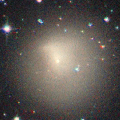
|
Major outburst occured between Nov. 1 and 2. Another outburst occured in late November. Now it is 11.8 mag (Jan. 19, Michael Jager). It stays observable in good condition.
Date(TT) R.A. (2000) Decl. Delta r Elong. m1 Best Time(A, h)
Jan. 25 10 3.88 9 6.9 5.352 6.258 154 13.6 1:48 ( 0, 64)
Feb. 1 10 0.99 9 16.3 5.312 6.259 162 13.6 1:17 ( 0, 64)
|

|
Now it is 14.0 mag (Jan. 4, W. Pei). It stays 14 mag for a while. It stays observable in good condition.
Date(TT) R.A. (2000) Decl. Delta r Elong. m1 Best Time(A, h)
Jan. 25 6 21.35 7 1.0 4.880 5.729 146 14.1 22:02 ( 0, 62)
Feb. 1 6 19.28 7 40.9 4.922 5.714 140 14.1 21:32 ( 0, 63)
|

|
It brightened up to 12.7 mag in summer (Aug. 7, Thomas Lehmann). Now it is 14.2 mag (Dec. 10, Ken-ichi Kadota). It stays 15 mag for a while. Now it is not observable. It will appear in February in the Northern Hemisphere, or in March in the Southern Hemisphere.
Date(TT) R.A. (2000) Decl. Delta r Elong. m1 Best Time(A, h)
Jan. 25 20 49.22 -5 3.6 3.429 2.490 14 14.1 18:48 ( 89, -6)
Feb. 1 21 0.27 -2 57.7 3.459 2.515 14 14.2 18:55 ( 94,-10)
|

|
Brightened rapidly. Now it is 14.9 mag (Dec. 29, Ken-ichi Kadota). It stays 14 mag for a while. In the Northern Hemisphere, it will be unobservable in April. In the Southern Hemisphere, it is not observable now, but it will appear in May.
Date(TT) R.A. (2000) Decl. Delta r Elong. m1 Best Time(A, h)
Jan. 25 20 42.44 29 16.2 2.442 1.934 48 14.2 18:48 (118, 12)
Feb. 1 21 6.22 28 15.7 2.462 1.905 45 14.2 18:55 (118, 10)
|

|
Now it is 13.6 mag (Jan. 5, Chris Wyatt). It stays 14 mag for a while. It stays observable in good condition.
Date(TT) R.A. (2000) Decl. Delta r Elong. m1 Best Time(A, h)
Jan. 25 15 18.31 -18 2.9 5.294 5.094 72 14.2 5:35 (335, 33)
Feb. 1 15 22.38 -17 39.7 5.196 5.105 79 14.2 5:32 (341, 35)
|

|
It returns for the first time in 70 years. It brightened up to 3.7 mag in early April (Apr. 6, Jose Guilherme Aguiar). Now it is 15.0 mag (Jan. 10, Thomas Lehmann). It stays 15 mag for a while. In the Northern Hemisphere, it is not observable now, but it will appear in February. In the Southern Hemisphere, it stays observable in good condition.
Date(TT) R.A. (2000) Decl. Delta r Elong. m1 Best Time(A, h)
Jan. 25 16 57.22 -48 53.0 4.451 3.918 51 14.2 5:35 (332, -3)
Feb. 1 17 2.95 -49 6.5 4.443 3.989 56 14.3 5:32 (334, -2)
|

|
Now it is 14.4 mag (Jan. 9, Thomas Lehmann). Fading slowly. It stays observable in good condition.
Date(TT) R.A. (2000) Decl. Delta r Elong. m1 Best Time(A, h)
Jan. 25 9 2.10 18 56.4 1.647 2.626 172 14.5 0:46 ( 0, 74)
Feb. 1 8 56.22 18 51.9 1.638 2.623 178 14.4 0:13 ( 0, 74)
|

|
It is expected to brighten up to 13 mag in 2025 autumn, and it will be observable in good condition. Now it is 14.8 mag (Jan. 14, Ken-ichi Kadota). It stays 14 mag for a while. It will be unobservable in February in the Southern Hemisphere, or in March in the Northern Hemisphere. But it will be observable again in May in the Southern Hemisphere.
Date(TT) R.A. (2000) Decl. Delta r Elong. m1 Best Time(A, h)
Jan. 25 23 25.33 -0 13.4 4.770 4.163 47 14.6 18:48 ( 68, 28)
Feb. 1 23 32.41 0 33.2 4.820 4.140 41 14.6 18:55 ( 74, 23)
|

|
It brightened up to 12.3 mag in autumn (Oct. 31, Thomas Lehmann). It will fade out rapidly after this. It will be fainter than 18 mag in May. In the Northern Hemisphere, it will be unobservable in February. In the Southern Hemisphere, it will never be observable after this.
Date(TT) R.A. (2000) Decl. Delta r Elong. m1 Best Time(A, h)
Jan. 25 21 58.26 -9 31.5 2.770 1.909 23 15.0 18:48 ( 75, 5)
Feb. 1 22 14.56 -7 44.1 2.832 1.943 20 15.2 18:55 ( 79, 3)
|

|
Now it is 13.9 mag (Jan. 6, Thomas Lehmann). Fading slowly. In the Northern Hemisphere, it stays observable in good condition. In the Southern Hemisphere, it is not observable now, but it will appear in April.
Date(TT) R.A. (2000) Decl. Delta r Elong. m1 Best Time(A, h)
Jan. 25 7 59.17 74 5.4 1.954 2.642 124 15.0 23:40 (180, 51)
Feb. 1 7 51.03 72 50.5 1.985 2.660 123 15.1 23:05 (180, 52)
|
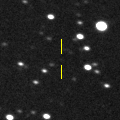
|
Now it is 16.6 mag (Oct. 9, Hidetaka Sato). It stays 15 mag for a while. Now it is not observable. It will appear in March in the Southern Hemisphere.
Date(TT) R.A. (2000) Decl. Delta r Elong. m1 Best Time(A, h)
Jan. 25 20 50.05 -20 51.5 3.006 2.027 5 15.1 18:48 ( 75,-15)
Feb. 1 21 7.72 -20 1.9 3.003 2.020 3 15.0 18:55 ( 78,-18)
|

|
It approached to Earth down to 0.55 a.u. in early December, and it brightened up to 10.7 mag (Dec. 5, Mike Olason). Now it is 14.2 mag (Jan. 12, Thomas Lehmann). Fading rapidly. It will be fainter than 18 mag in March. It locates somewhat low in the Northern Hemisphere. In the Southern Hemisphere, it will never be observable after this.
Date(TT) R.A. (2000) Decl. Delta r Elong. m1 Best Time(A, h)
Jan. 25 22 19.48 30 19.5 1.631 1.355 56 15.1 18:48 (108, 31)
Feb. 1 22 27.37 28 36.2 1.810 1.409 50 15.7 18:55 (109, 25)
|
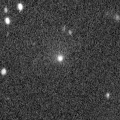
|
Very large comet. It is expected to brighten up to 13 mag in 2031. Now it is 15.1 mag (Jan. 9, Thomas Lehmann). It stays 15 mag for a while. In the Northern Hemisphere, it is not observable now. In the Southern Hemisphere, it stays observable in good condition. In the Northern Hemisphere, it is not observable until 2030.
Date(TT) R.A. (2000) Decl. Delta r Elong. m1 Best Time(A, h)
Jan. 25 3 32.25 -69 25.1 15.690 15.508 77 15.4 19:12 ( 0,-14)
Feb. 1 3 31.80 -69 5.3 15.677 15.485 76 15.4 18:55 ( 1,-14)
|

|
Now it is 15.5 mag (Jan. 19, Michael Jager). Brightening slowly. It locates somewhat low.
Date(TT) R.A. (2000) Decl. Delta r Elong. m1 Best Time(A, h)
Jan. 25 0 57.54 -12 9.3 1.813 1.652 64 15.7 18:48 ( 39, 34)
Feb. 1 1 11.70 -9 46.0 1.827 1.616 61 15.5 18:55 ( 45, 33)
|

|
First return of a new periodic comet which brightened up to 15 mag in 2010. Now it is 16.9 mag (Jan. 19, Michael Jager). It stays 16 mag for a while. In the Northern Hemisphere, it stays observable in good condition. It locates somewhat low in the Southern Hemisphere.
Date(TT) R.A. (2000) Decl. Delta r Elong. m1 Best Time(A, h)
Jan. 25 2 36.65 20 50.2 1.249 1.699 98 15.7 18:48 ( 27, 75)
Feb. 1 2 47.45 22 46.3 1.286 1.677 94 15.6 18:55 ( 47, 73)
|

|
Now it is 15.8 mag (Jan. 6, A. Pearce, T. Lovejoy). It stays 16 mag for a while. It stays observable in good condition.
Date(TT) R.A. (2000) Decl. Delta r Elong. m1 Best Time(A, h)
Jan. 25 7 6.69 -17 53.1 3.278 4.062 137 15.6 22:46 ( 0, 37)
Feb. 1 6 59.00 -15 47.6 3.278 4.044 135 15.6 22:11 ( 0, 39)
|

|
Now it is 15.7 mag (Jan. 10, Ken-ichi Kadota). It stays 16 mag for a while. It will be unobservable in May.
Date(TT) R.A. (2000) Decl. Delta r Elong. m1 Best Time(A, h)
Jan. 25 2 1.65 14 14.3 2.643 2.793 88 15.6 18:48 ( 40, 65)
Feb. 1 2 8.40 14 28.5 2.715 2.771 82 15.6 18:55 ( 51, 61)
|

|
Now it is 16.1 mag (Jan. 4, Ken-ichi Kadota). It stays 16 mag for a while. It locates somewhat low in the Northern Hemisphere. In the Southern Hemisphere, it stays observable in good condition.
Date(TT) R.A. (2000) Decl. Delta r Elong. m1 Best Time(A, h)
Jan. 25 13 8.77 -33 40.2 3.322 3.548 95 15.8 4:52 ( 0, 21)
Feb. 1 13 13.05 -34 21.7 3.235 3.549 100 15.8 4:29 ( 0, 21)
|

|
Now it is 16.1 mag (Jan. 12, ATLAS-HKO, Haleakala). It stays 16 mag for a while. In the Northern Hemisphere, it stays observable in good condition. In the Southern Hemisphere, it will be unobservable in February.
Date(TT) R.A. (2000) Decl. Delta r Elong. m1 Best Time(A, h)
Jan. 25 12 26.73 45 21.3 3.867 4.501 124 15.8 4:10 (180, 80)
Feb. 1 12 25.23 47 48.9 3.811 4.485 127 15.8 3:41 (180, 77)
|

|
Peculiar asteroid moving along a cometary orbit. It approaches to Sun down to 0.1 a.u. on Jan. 29. It will fade out rapidly after this. It will be fainter than 18 mag in February. Now it is not observable. It will appear in March in the Southern Hemisphere. In the Northern Hemisphere, it will never be observable after this.
Date(TT) R.A. (2000) Decl. Delta r Elong. m1 Best Time(A, h)
Jan. 25 20 6.17 -19 11.5 1.208 0.246 5 15.8 5:35 (284,-13)
Feb. 1 21 26.46 -16 16.2 0.885 0.151 6 18.6 18:55 ( 79,-12)
|

|
Now it is 15.8 mag (Jan. 3, Ken-ichi Kadota). Fading slowly. It stays observable in good condition.
Date(TT) R.A. (2000) Decl. Delta r Elong. m1 Best Time(A, h)
Jan. 25 6 10.44 9 41.7 2.795 3.647 145 15.9 21:51 ( 0, 65)
Feb. 1 6 8.67 9 55.8 2.870 3.665 138 15.9 21:22 ( 0, 65)
|

|
Bright new comet. Now it is 15.8 mag (Jan. 24, Martin Masek). It will fade out rapidly after this. It will be fainter than 18 mag in March. In the Northern Hemisphere, it will be getting higher gradually. In the Southern Hemisphere, it stays observable in good condition.
Date(TT) R.A. (2000) Decl. Delta r Elong. m1 Best Time(A, h)
Jan. 25 2 54.41 -41 22.5 1.056 1.341 82 15.9 18:48 ( 2, 14)
Feb. 1 3 20.38 -32 21.7 1.121 1.433 85 16.3 18:55 ( 5, 23)
|
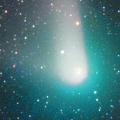
|
It brightened up to 8 mag from 2022 summer to 2023 spring. Now it is 15.4 mag (Jan. 1, W. Pei). It stays 17 mag for a while. In the Northern Hemisphere, it stays observable in good condition. It locates somewhat low in the Southern Hemisphere.
Date(TT) R.A. (2000) Decl. Delta r Elong. m1 Best Time(A, h)
Jan. 25 5 31.49 22 2.2 7.056 7.820 138 15.9 21:12 ( 0, 77)
Feb. 1 5 28.65 22 15.1 7.195 7.873 130 16.0 20:42 ( 0, 77)
|

|
It brightened up to 13.1 mag in autumn (Nov. 1, Thomas Lehmann). Now it is 16.1 mag (Jan. 4, Ken-ichi Kadota). Fading gradually. It will be fainter than 18 mag in April. In the Northern Hemisphere, it stays observable in good condition. In the Southern Hemisphere, it is not observable now, but it will appear in February.
Date(TT) R.A. (2000) Decl. Delta r Elong. m1 Best Time(A, h)
Jan. 25 17 37.56 16 56.0 2.574 2.172 55 15.9 5:35 (275, 37)
Feb. 1 17 45.09 16 13.5 2.588 2.230 58 16.1 5:32 (278, 40)
|
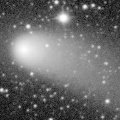
|
It brightened up to 9.6 mag from February to March in 2024 (Feb. 25, 2024, Thomas Lehmann). Now it is 15.3 mag (Dec. 28, Thomas Lehmann). It stays 17 mag for a while. It locates somewhat low in the Northern Hemisphere. But it will become high in spring. In the Southern Hemisphere, it is not observable now, but it will appear in May.
Date(TT) R.A. (2000) Decl. Delta r Elong. m1 Best Time(A, h)
Jan. 25 21 49.43 30 57.6 4.979 4.465 53 16.0 18:48 (112, 25)
Feb. 1 21 57.74 31 3.0 5.098 4.533 50 16.1 18:55 (114, 20)
|

|
Now it is 16.5 mag (June 6, Giuseppe Pappa). It stays 16 mag for a while. It stays extremely low in the Northern Hemisphere. In the Southern Hemisphere, it stays observable in good condition.
Date(TT) R.A. (2000) Decl. Delta r Elong. m1 Best Time(A, h)
Jan. 25 13 27.54 -46 16.9 5.159 5.191 86 16.2 5:11 ( 0, 9)
Feb. 1 13 20.97 -46 45.6 5.044 5.191 93 16.2 4:37 ( 0, 8)
|
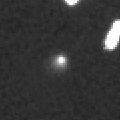
|
Now it is 16.0 mag (Jan. 11, ATLAS South Africa). It stays 16 mag for a while. In the Northern Hemisphere, it will be unobservable in May. In the Southern Hemisphere, it stays observable in good condition.
Date(TT) R.A. (2000) Decl. Delta r Elong. m1 Best Time(A, h)
Jan. 25 6 46.69 -28 33.5 6.090 6.720 126 16.2 22:27 ( 0, 26)
Feb. 1 6 44.46 -27 48.3 6.102 6.710 124 16.2 21:57 ( 0, 27)
|
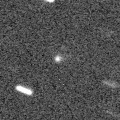
|
Now it is 17.3 mag (Jan. 5, ATLAS-HKO, Haleakala). Fading slowly. It stays observable in good condition.
Date(TT) R.A. (2000) Decl. Delta r Elong. m1 Best Time(A, h)
Jan. 25 14 40.27 -6 49.6 2.159 2.296 85 16.4 5:35 (343, 47)
Feb. 1 14 47.88 -6 59.9 2.106 2.331 90 16.4 5:32 (348, 47)
|
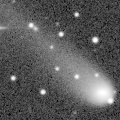
|
Now it is 15.8 mag (Jan. 5, ATLAS Chile). It stays 17 mag for a while. In the Northern Hemisphere, it will be unobservable in April. In the Southern Hemisphere, it stays observable in good condition.
Date(TT) R.A. (2000) Decl. Delta r Elong. m1 Best Time(A, h)
Jan. 25 5 57.52 -49 52.5 6.386 6.682 103 16.4 21:37 ( 0, 5)
Feb. 1 5 49.93 -49 8.5 6.458 6.727 101 16.5 21:02 ( 0, 6)
|

|
Almost stellar. It brightened up to 13.7 mag from late November to early December (Dec. 5, Toshihiko Ikemura, Hirohisa Sato). Now it is 16.4 mag (Jan. 12, Thomas Lehmann). Fading gradually. It will be fainter than 18 mag in March. In the Northern Hemisphere, it stays observable in good condition. In the Southern Hemisphere, it will never be observable after this.
Date(TT) R.A. (2000) Decl. Delta r Elong. m1 Best Time(A, h)
Jan. 25 2 25.29 47 15.1 1.412 1.897 103 16.4 18:48 (151, 75)
Feb. 1 2 20.74 48 58.9 1.552 1.937 96 16.7 18:55 (140, 70)
|
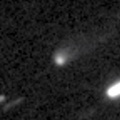
|
Now it is 16.2 mag (July 30, Thomas Lehmann). Brightening slowly. It locates somewhat low in the Northern Hemisphere. In the Southern Hemisphere, it will be getting higher gradually.
Date(TT) R.A. (2000) Decl. Delta r Elong. m1 Best Time(A, h)
Jan. 25 17 10.08 -23 20.0 3.604 3.010 46 16.6 5:35 (314, 15)
Feb. 1 17 20.96 -23 43.9 3.524 3.002 50 16.5 5:32 (316, 17)
|

|
Now it is 16.8 mag (Jan. 10, A. Diepvens). Brightening slowly. In the Northern Hemisphere, it will be unobservable in February. But it will be observable again in March. In the Southern Hemisphere, it is not observable now, but it will appear in April.
Date(TT) R.A. (2000) Decl. Delta r Elong. m1 Best Time(A, h)
Jan. 25 22 14.51 17 4.7 5.931 5.274 44 16.6 18:48 ( 95, 23)
Feb. 1 22 16.27 16 58.4 5.958 5.232 39 16.6 18:55 ( 99, 17)
|

|
Now it is 16.7 mag (Jan. 14, ATLAS Chile). It stays 16 mag for a while. It locates somewhat low in the Northern Hemisphere. But it will become high in spring. In the Southern Hemisphere, it stays observable in good condition.
Date(TT) R.A. (2000) Decl. Delta r Elong. m1 Best Time(A, h)
Jan. 25 15 12.98 -30 53.2 3.647 3.458 71 16.7 5:35 (341, 21)
Feb. 1 15 8.57 -31 4.1 3.499 3.450 79 16.6 5:32 (348, 23)
|

|
First return of a new periodic comet which brightened up to 16 mag in 2012. Now it is 15.9 mag (Jan. 7, Ken-ichi Kadota). It will fade out rapidly after this. It will be fainter than 18 mag in February. In the Northern Hemisphere, it stays observable in good condition. In the Southern Hemisphere, it will never be observable after this.
Date(TT) R.A. (2000) Decl. Delta r Elong. m1 Best Time(A, h)
Jan. 25 2 49.36 56 59.8 1.522 2.060 108 16.6 18:48 (174, 68)
Feb. 1 2 58.03 57 24.8 1.617 2.093 104 17.0 18:55 (166, 66)
|
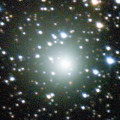
|
It brightened up to 8.3 mag in 2021-2022 winter (Jan. 6, 2022, Toshiyuki Takahashi). Now it is 17.1 mag (Dec. 30, ATLAS South Africa). It stays 17 mag for a while. In the Northern Hemisphere, it will never be observable after this. In the Southern Hemisphere, it stays observable in good condition.
Date(TT) R.A. (2000) Decl. Delta r Elong. m1 Best Time(A, h)
Jan. 25 12 39.36 -58 6.7 9.515 9.520 87 16.7 4:23 ( 0, -3)
Feb. 1 12 38.23 -58 37.5 9.481 9.564 91 16.7 3:54 ( 0, -4)
|

|
Parent asteroid of Geminids meteor shower. Now it is 16.0 mag (Nov. 30, Katsumi Yoshimoto). It will brighten rapidly after this. It will be unobservable in March. But it will be observable again in May in the Northern Hemisphere.
Date(TT) R.A. (2000) Decl. Delta r Elong. m1 Best Time(A, h)
Jan. 25 1 31.18 15 43.1 1.048 1.334 82 16.8 18:48 ( 54, 61)
Feb. 1 1 30.27 14 4.4 1.071 1.241 74 16.8 18:55 ( 63, 54)
|
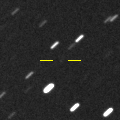
|
It stays 17 mag for a while. It locates somewhat low in the Northern Hemisphere. But it will become high in spring. In the Southern Hemisphere, it will be getting higher gradually.
Date(TT) R.A. (2000) Decl. Delta r Elong. m1 Best Time(A, h)
Jan. 25 17 15.66 -17 45.9 2.614 2.052 45 16.8 5:35 (309, 19)
Feb. 1 17 32.14 -17 39.8 2.561 2.053 48 16.8 5:32 (310, 20)
|

|
Now it is 16.9 mag (Jan. 9, ATLAS South Africa). It stays 17 mag for a while. It stays observable in good condition.
Date(TT) R.A. (2000) Decl. Delta r Elong. m1 Best Time(A, h)
Jan. 25 6 28.53 -8 53.8 3.734 4.526 139 16.8 22:09 ( 0, 46)
Feb. 1 6 25.41 -8 51.1 3.777 4.520 134 16.9 21:38 ( 0, 46)
|
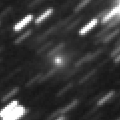
|
Very far object. Now it is 16.9 mag (Dec. 20, ATLAS Chile). It stays 17 mag for a while. In the Northern Hemisphere, it is not observable now. In the Southern Hemisphere, it will be getting lower gradually. But it will be getting higher again after April.
Date(TT) R.A. (2000) Decl. Delta r Elong. m1 Best Time(A, h)
Jan. 25 0 45.55 -60 28.6 11.018 10.573 60 17.0 18:48 ( 17,-10)
Feb. 1 0 46.54 -59 40.9 11.057 10.582 58 17.0 18:55 ( 21,-11)
|

|
Now it is 16.6 mag (Jan. 13, ATLAS Chile). Fading slowly. It will be fainter than 18 mag in March. It locates somewhat low in the Northern Hemisphere. In the Southern Hemisphere, it stays observable in good condition.
Date(TT) R.A. (2000) Decl. Delta r Elong. m1 Best Time(A, h)
Jan. 25 7 20.74 -41 37.1 3.630 4.175 117 17.0 22:59 ( 0, 13)
Feb. 1 7 6.59 -40 21.5 3.686 4.225 116 17.1 22:18 ( 0, 15)
|
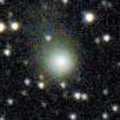
|
It brightened up to 12.1 mag in 2023 spring (May 20, 2023, Jose Guilherme de S. Aguiar). Now it is 17.1 mag (Jan. 4, ATLAS South Africa). It stays 18 mag for a while. In the Northern Hemisphere, it will be unobservable in April. In the Southern Hemisphere, it stays observable in good condition.
Date(TT) R.A. (2000) Decl. Delta r Elong. m1 Best Time(A, h)
Jan. 25 5 45.34 -36 36.8 5.960 6.398 112 17.1 21:25 ( 0, 18)
Feb. 1 5 41.50 -35 28.2 6.047 6.447 109 17.2 20:54 ( 0, 20)
|

|
Now it is 17.2 mag (Jan. 1, ATLAS-HKO, Haleakala). It stays 18 mag for a while. It will be getting lower gradually after this, and it will be unobservable in May.
Date(TT) R.A. (2000) Decl. Delta r Elong. m1 Best Time(A, h)
Jan. 25 2 45.83 8 53.3 3.663 3.904 96 17.1 18:48 ( 12, 64)
Feb. 1 2 49.21 9 5.7 3.769 3.906 90 17.2 18:55 ( 28, 62)
|
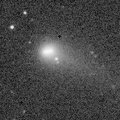
|
It brightened up to 13.5 mag in last winter (Dec. 5, 2023, Chris Wyatt). Now it is 17.8 mag (Dec. 28, ATLAS-HKO, Haleakala). It stays 18 mag for a while. It stays observable in good condition.
Date(TT) R.A. (2000) Decl. Delta r Elong. m1 Best Time(A, h)
Jan. 25 14 22.55 -7 25.5 2.925 3.071 89 17.2 5:35 (349, 47)
Feb. 1 14 26.29 -7 42.5 2.861 3.109 95 17.2 5:32 (356, 47)
|

|
It has not been observed yet in this apparition. It will approach to Earth down to 0.3 a.u. in March, and it is expected to brighten up to 16 mag. It brightens up to 16 mag, but it will turn to fade out rapidly after that. It will be fainter than 18 mag in April. In the Northern Hemisphere, it stays observable in good condition. In the Southern Hemisphere, it will be getting lower gradually after this, and it will be unobservable in March.
Date(TT) R.A. (2000) Decl. Delta r Elong. m1 Best Time(A, h)
Jan. 25 2 23.93 -20 40.2 0.587 1.076 82 17.7 18:48 ( 12, 34)
Feb. 1 2 30.40 -15 43.6 0.542 1.030 79 17.3 18:55 ( 21, 37)
|

|
Now it is 17.1 mag (Jan. 13, Catalina Sky Survey). It will fade out rapidly after this. It will be fainter than 18 mag in February. In the Northern Hemisphere, it stays observable in good condition. It locates somewhat low in the Southern Hemisphere.
Date(TT) R.A. (2000) Decl. Delta r Elong. m1 Best Time(A, h)
Jan. 25 2 26.01 10 24.2 1.260 1.635 92 17.3 18:48 ( 23, 64)
Feb. 1 2 45.41 11 8.5 1.350 1.676 90 17.5 18:55 ( 31, 63)
|

|
It brightened up to 14 mag from summer to autumn. Now it is 17.0 mag (Jan. 10, Ken-ichi Kadota). Fading gradually. It will be fainter than 18 mag in February. In the Northern Hemisphere, it will be getting lower gradually. It locates somewhat low in the Southern Hemisphere.
Date(TT) R.A. (2000) Decl. Delta r Elong. m1 Best Time(A, h)
Jan. 25 2 10.49 11 18.3 2.684 2.849 89 17.3 18:48 ( 32, 63)
Feb. 1 2 16.79 12 3.9 2.814 2.882 83 17.5 18:55 ( 45, 60)
|

|
Now it is 17.3 mag (Jan. 13, ATLAS South Africa). It stays 18 mag for a while. In the Northern Hemisphere, it will be getting lower gradually after this, and it will be unobservable in April. In the Southern Hemisphere, it stays observable in good condition.
Date(TT) R.A. (2000) Decl. Delta r Elong. m1 Best Time(A, h)
Jan. 25 3 46.62 -14 19.8 3.637 3.974 102 17.3 19:27 ( 0, 41)
Feb. 1 3 48.15 -13 34.7 3.724 3.976 97 17.4 19:01 ( 0, 42)
|

|
Now it is 17.1 mag (Jan. 7, ATLAS-HKO, Haleakala). It will fade out rapidly after this. It will be fainter than 18 mag in February. It stays observable in good condition.
Date(TT) R.A. (2000) Decl. Delta r Elong. m1 Best Time(A, h)
Jan. 25 6 58.75 15 22.4 1.046 1.994 158 17.4 22:39 ( 0, 70)
Feb. 1 6 56.31 14 19.2 1.089 2.006 150 17.5 22:09 ( 0, 69)
|

|
Now it is 17.4 mag (Jan. 4, B. Lutkenhoner, E. Cortes). It stays 17 mag for a while. It stays extremely low in the Northern Hemisphere. But it will become high in winter. In the Southern Hemisphere, it stays observable in good condition.
Date(TT) R.A. (2000) Decl. Delta r Elong. m1 Best Time(A, h)
Jan. 25 12 52.73 -48 37.8 5.347 5.447 90 17.5 4:36 ( 0, 6)
Feb. 1 12 48.17 -48 35.0 5.233 5.437 96 17.4 4:04 ( 0, 6)
|

|
Peculiar asteroid moving along a cometary orbit. Now it is 18.5 mag (Sept. 11, ATLAS-HKO, Haleakala). It stays 17 mag for a while. It stays observable in good condition.
Date(TT) R.A. (2000) Decl. Delta r Elong. m1 Best Time(A, h)
Jan. 25 3 23.57 -13 49.0 2.017 2.364 97 17.5 19:05 ( 0, 41)
Feb. 1 3 27.44 -12 56.2 2.047 2.319 93 17.5 18:55 ( 4, 42)
|
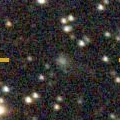
|
Now it is 17.3 mag (Jan. 8, ATLAS-HKO, Haleakala). It stays 18 mag for a while. In the Northern Hemisphere, it stays observable in good condition. It stays extremely low in the Southern Hemisphere.
Date(TT) R.A. (2000) Decl. Delta r Elong. m1 Best Time(A, h)
Jan. 25 7 21.11 41 54.0 6.255 7.146 152 17.6 23:02 (180, 83)
Feb. 1 7 18.49 41 47.5 6.312 7.162 147 17.6 22:32 (180, 83)
|

|
It is expected to brighten up to 5 mag in 2026 January. Now it is 17.6 mag (Jan. 4, ATLAS-HKO, Haleakala). Brightening gradually. In the Northern Hemisphere, it stays observable in good condition. In the Southern Hemisphere, it is not observable now, but it will appear in March.
Date(TT) R.A. (2000) Decl. Delta r Elong. m1 Best Time(A, h)
Jan. 25 17 43.32 41 14.5 5.298 5.071 71 17.7 5:35 (244, 45)
Feb. 1 17 49.81 41 40.3 5.196 5.000 73 17.6 5:32 (244, 48)
|

|
It brightened up to 12.0 mag in June (June 13, Ken-ichi Kadota). Now it is 17.9 mag (Jan. 8, D29 Purple Mountain Observatory, XuYi Station). Fading gradually. It will be fainter than 18 mag in February. In the Northern Hemisphere, it stays observable in good condition. It locates somewhat low in the Southern Hemisphere.
Date(TT) R.A. (2000) Decl. Delta r Elong. m1 Best Time(A, h)
Jan. 25 9 6.29 33 23.0 1.819 2.777 163 17.6 0:51 ( 0, 88)
Feb. 1 8 57.51 33 14.3 1.867 2.827 163 17.8 0:15 ( 0, 88)
|

|
First return of a new periodic comet which brightened up to 15 mag in 2010. Now it is 17.2 mag (Dec. 27, Michael Jager). It will fade out rapidly after this. It will be fainter than 18 mag in February. In the Northern Hemisphere, it stays observable in good condition. It locates somewhat low in the Southern Hemisphere.
Date(TT) R.A. (2000) Decl. Delta r Elong. m1 Best Time(A, h)
Jan. 25 9 21.89 32 15.3 1.652 2.607 162 17.7 1:06 ( 0, 87)
Feb. 1 9 14.58 32 22.9 1.692 2.654 164 17.9 0:32 ( 0, 87)
|
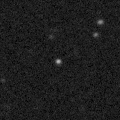
|
Now it is 18.0 mag (Aug. 18, Taras Prystavski). It stays 18 mag for a while. In the Northern Hemisphere, it stays observable in good condition. It locates somewhat low in the Southern Hemisphere.
Date(TT) R.A. (2000) Decl. Delta r Elong. m1 Best Time(A, h)
Jan. 25 7 1.47 36 45.3 7.937 8.831 153 17.8 22:42 (180, 88)
Feb. 1 6 56.17 36 26.6 7.995 8.837 146 17.9 22:09 (180, 89)
|

|
Now it is 17.6 mag (Jan. 6, ATLAS-MLO, Mauna Loa). It stays 18 mag for a while. In the Northern Hemisphere, it stays observable in good condition. In the Southern Hemisphere, it is not observable now, but it will appear in February.
Date(TT) R.A. (2000) Decl. Delta r Elong. m1 Best Time(A, h)
Jan. 25 9 53.58 63 45.3 1.661 2.441 133 18.0 1:39 (180, 61)
Feb. 1 9 28.91 62 14.0 1.621 2.417 134 17.9 0:47 (180, 63)
|
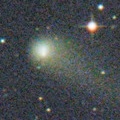
|
It brightened up to 11 mag in 2022 spring. Now it is 18.0 mag (Nov. 12, D. Buczynski). It stays 18 mag for a while. In the Northern Hemisphere, it stays observable in good condition. In the Southern Hemisphere, it will never be observable after this.
Date(TT) R.A. (2000) Decl. Delta r Elong. m1 Best Time(A, h)
Jan. 25 18 29.74 25 8.8 9.046 8.488 52 17.9 5:35 (259, 30)
Feb. 1 18 33.73 25 32.5 9.052 8.529 55 18.0 5:32 (261, 35)
|

|
It will approach to Sun down to 0.04 a.u. on Mar. 14. It approaches to Earth down to 0.2 a.u. in mid February, and it will be observable in good condition. It will be getting lower gradually.
Date(TT) R.A. (2000) Decl. Delta r Elong. m1 Best Time(A, h)
Jan. 25 13 10.36 -9 27.9 0.683 1.336 105 22.5 4:53 ( 0, 45)
Feb. 1 13 40.26 -13 8.6 0.499 1.208 104 21.8 4:55 ( 0, 42)
|
|
![]()
 21P/Giacobini-Zinner
21P/Giacobini-Zinner 13P/Olbers
13P/Olbers C/2022 E2 ( ATLAS )
C/2022 E2 ( ATLAS ) 29P/Schwassmann-Wachmann 1
29P/Schwassmann-Wachmann 1 C/2022 QE78 ( ATLAS )
C/2022 QE78 ( ATLAS ) C/2023 C2 ( ATLAS )
C/2023 C2 ( ATLAS ) C/2024 J2 ( Wierzchos )
C/2024 J2 ( Wierzchos ) C/2021 G2 ( ATLAS )
C/2021 G2 ( ATLAS ) 12P/Pons-Brooks
12P/Pons-Brooks P/2023 S1
P/2023 S1 C/2022 N2 ( PanSTARRS )
C/2022 N2 ( PanSTARRS ) 37P/Forbes
37P/Forbes C/2023 Q1 ( PanSTARRS )
C/2023 Q1 ( PanSTARRS ) 48P/Johnson
48P/Johnson 333P/LINEAR
333P/LINEAR C/2014 UN271 ( Bernardinelli-Bernstein )
C/2014 UN271 ( Bernardinelli-Bernstein ) 49P/Arend-Rigaux
49P/Arend-Rigaux 496P/2024 S3 ( Hill )
496P/2024 S3 ( Hill ) C/2024 A1 ( ATLAS )
C/2024 A1 ( ATLAS ) 43P/Wolf-Harrington
43P/Wolf-Harrington C/2023 T3 ( Fuls )
C/2023 T3 ( Fuls ) C/2023 H5 ( Lemmon )
C/2023 H5 ( Lemmon ) (465402) 2008 HW1
(465402) 2008 HW1 472P/2023 RL75 ( NEAT-LINEAR )
472P/2023 RL75 ( NEAT-LINEAR ) C/2024 Y1 ( Masek )
C/2024 Y1 ( Masek ) C/2017 K2 ( PanSTARRS )
C/2017 K2 ( PanSTARRS ) C/2024 B1 ( Lemmon )
C/2024 B1 ( Lemmon ) C/2021 S3 ( PanSTARRS )
C/2021 S3 ( PanSTARRS ) C/2023 F3 ( ATLAS )
C/2023 F3 ( ATLAS ) C/2022 R6 ( PanSTARRS )
C/2022 R6 ( PanSTARRS ) 30P/Reinmuth 1
30P/Reinmuth 1 C/2019 U5 ( PanSTARRS )
C/2019 U5 ( PanSTARRS ) C/2024 M1 ( ATLAS )
C/2024 M1 ( ATLAS ) 65P/Gunn
65P/Gunn C/2023 R1 ( PanSTARRS )
C/2023 R1 ( PanSTARRS ) C/2024 L5 ( ATLAS )
C/2024 L5 ( ATLAS ) 487P/2024 N5 ( Siding Spring )
487P/2024 N5 ( Siding Spring ) C/2019 L3 ( ATLAS )
C/2019 L3 ( ATLAS ) (3200) Phaethon
(3200) Phaethon 105P/Singer Brewster
105P/Singer Brewster 195P/Hill
195P/Hill C/2019 E3 ( ATLAS )
C/2019 E3 ( ATLAS ) C/2022 L2 ( ATLAS )
C/2022 L2 ( ATLAS ) C/2020 K1 ( PanSTARRS )
C/2020 K1 ( PanSTARRS ) 276P/Vorobjov
276P/Vorobjov 32P/Comas Sola
32P/Comas Sola P/2019 Y3 ( Catalina )
P/2019 Y3 ( Catalina ) 305P/Skiff
305P/Skiff 130P/McNaught-Hughes
130P/McNaught-Hughes 242P/Spahr
242P/Spahr P/2015 CD60 ( LINEAR )
P/2015 CD60 ( LINEAR ) C/2024 G2 ( ATLAS )
C/2024 G2 ( ATLAS ) (308607) 2005 WY3
(308607) 2005 WY3 C/2021 S4 ( Tsuchinshan )
C/2021 S4 ( Tsuchinshan ) C/2024 E1 ( Wierzchos )
C/2024 E1 ( Wierzchos ) 154P/Brewington
154P/Brewington 492P/2024 O3 ( LINEAR )
492P/2024 O3 ( LINEAR ) (468861) 2013 LU28
(468861) 2013 LU28 C/2024 V1 ( Borisov )
C/2024 V1 ( Borisov ) C/2019 T4 ( ATLAS )
C/2019 T4 ( ATLAS ) 323P/SOHO
323P/SOHO![]()























































